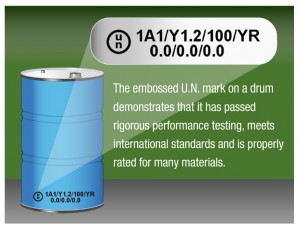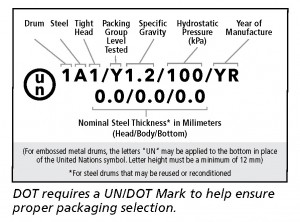
Many laws and regulations govern the packaging and transport of dangerous goods, otherwise known as hazardous materials. The primary purpose of these regulations is to prevent the accidental release of a product during handling and shipment in order to protect workers, the environment and the public. Typically, there is one set of regulations governing their use in the workplace, and a separate set of regulations that applies to transporting such materials.
In the United States, the Department of Transportation (DOT) regulates the movement of hazardous materials in commerce. To ensure the safe shipment of hazardous materials, DOT has adopted a model developed by the United Nations (UN) for the testing, selection and marking of containers used for dangerous goods. This scheme involves testing the packaging using the various UN/DOT guidelines to ensure the packaging’s integrity when transporting hazardous materials. Each packaging type will have undergone and passed stringent tests which correspond to the hazard or danger level of the material to be packaged.
The marking system employed by the UN model regulations is commonly referred to as a packaging’s “UN rating.”
To ensure that the right package is selected, the shipper must specify the characteristics of the product to be shipped by identifying characteristics such as hazard class and specific gravity. For example, your product may be of medium danger (Class II) with a specific gravity of 1.6. The corresponding package should be tested and certified to hold that type of product.

Click Here to Download Issue 6
How can you be sure you have selected packaging with the proper UN rating for your product?
Fortunately, DOT requires that all packaging intended for the use and transport of hazardous materials be marked on an external surface with the UN/DOT mark, indicating that packaging’s UN rating. Once you understand what the various symbols indicate, it’s easy to decipher the code and select the proper packaging.

For steel drums, a UN/DOT mark would use the following:
- 1 to indicate a drum.
- A to indicate steel.
- 1 to indicate a tight head style or 2 to indicate an open head style.
- X to indicate the container can be used for materials that fall within Packing Groups I, II or III; Y to indicate the container can be used for materials in Packing Groups II and III; and Z to indicate the container can be used for materials only in Packing Group III.
- Then comes either the specific gravity of the liquid to be transported or the gross mass that the container has been tested to handle.
- Next, an “S” will appear if the product is a solid; if a liquid, then the highest hydrostatic test pressure the packaging withstood during testing will be listed.
- Then, the year of the container’s manufacture is listed, along with the country authorizing the mark (USA) and the name or symbol of the entity certifying compliance, normally the manufacturer.
- Finally, for steel drums, the nominal steel thickness in millimeters is listed.
The responsibility for proper container selection rests with the person offering the package for shipment. You can reference 49 CFR § 173.22 for more details on the shipper’s responsibility regarding proper package selection. Your container supplier can assist you in selecting the proper packaging with the correct marking for your products.

